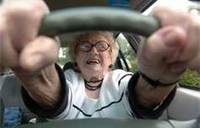Blind Spot Warning Systems Rated Top Tech Pick By Mature Drivers
 |
New technologies influence older driver confidence, according to survey
HARTFORD, CT--September, 17, 2013: Mature drivers rank Blind Spot Warning systems highest from a list of 10 new vehicle features, saying this technology would make them feel most safe when they drive, according to the Top Technologies for Mature Drivers: Consumer Insights survey, released today by The Hartford and the MIT AgeLab. Mature drivers who have at least one of the 10 technologies report feeling more confident as they drive than those who don’t have any of the technologies.
“As new technologies are incorporated into vehicles, it’s important for drivers of all ages to learn how to use them appropriately so that they enhance driver safety”
“As part of our recent research focus on mature drivers and technology, we wanted to understand what new features mature drivers themselves want in their vehicles,” says Jodi Olshevski, gerontologist and executive director of The Hartford Center for Mature Market Excellence. “The research suggests that mature drivers value technology that assists with changing lanes and parking. This is encouraging, and consistent with our previous research in which mature drivers identified turning their head to see blind spots as a challenging aspect of driving. It also supports our understanding of changes in flexibility and range of motion that can occur as we age.”
In the survey, consumers ranked a list of 10 vehicle technologies1 according to what they believed would make them feel the most safe when they drive.
Top Technologies for Mature Drivers: Consumer Ranking2
1. Blind spot warning systems: warns drivers of objects in blind spots, especially while changing lanes and parking, and helps those with limited range of motion
2. Crash mitigation systems: detects when the vehicle may be in danger of a collision and can help to minimize injuries to passengers
3. Emergency response systems: offers quick assistance to drivers in the case of a medical emergency or collision, often allowing emergency personnel to get to the scene more quickly
4. Drowsy driver alerts: monitor the degree to which a driver may be inattentive while on the road and helps alert drivers to the driving task
5. Reverse monitoring systems: warn of objects to the rear of the vehicle to help drivers judge distances and back up safely, and helps drivers with reduced flexibility
6. Vehicle stability control: helps to automatically bring the vehicle back in the intended line of travel, particularly in situations where the driver underestimates the angle of a curve or experiences weather effects, and reduces the likelihood of a crash
7. Lane departure warning: monitors the vehicle's position and warns the driver if the vehicle deviates outside the lane, helping drivers stay in their lane
8. Smart headlights: adjust the range and intensity of light based on the distance of traffic and to reduce glare and improve night vision
9. Voice activated systems: allow drivers to access features by voice command so they can keep focused on the road
10. Assistive parking systems: enable vehicles to park on their own or indicates distance to objects, reducing driver stress, making parking easier, and increasing the places that a driver can park
The survey found that 51 percent of mature drivers said they would feel safer if their vehicle had all of the most up-to-date technologies. Interestingly, women were more likely than men to report that having all 10 technologies would make them feel safer.
This new research also revealed that 55 percent of mature drivers plan to buy or lease another vehicle in the next five years, suggesting that as more and more of these features are incorporated into new vehicles, a growing number of consumers 50+ could be driving cars with these technologies.
“As new technologies are incorporated into vehicles, it’s important for drivers of all ages to learn how to use them appropriately so that they enhance driver safety,” said Joseph F. Coughlin, PhD, director of the MIT AgeLab. “This research shows that mature drivers are ready to consider new technologies and associate them with greater safety behind the wheel.”
This recent study is a follow up to the Top Technologies for Mature Drivers: Experts Ranking research conducted in 2012. The Hartford Center for Mature Market Excellence and the MIT AgeLab worked with a panel of leading experts in driving, aging and technology to conduct an extensive study that involved the review of 25 new technologies and the identification of 10 features that can benefit mature drivers.
“We encourage mature drivers to learn about these technologies and become comfortable using them, as these new features can bolster safety, comfort, and improve confidence,” said Olshevski.
To learn more about vehicle technologies and other ways to stay safe on the road, visit Lifetime Driving.
Top Technologies for Mature Drivers: Consumer Insights Survey Methodology
GfK Knowledge Networks conducted an online survey of adults over the age of 50 across the United States for The Hartford and the MIT AgeLab. A total of 927 interviews were completed with individuals who hold a valid drivers’ license and drive at least three days in a typical week. The data was weighted to match U.S. Census current population survey benchmarks. The survey was fielded in June 2013.


